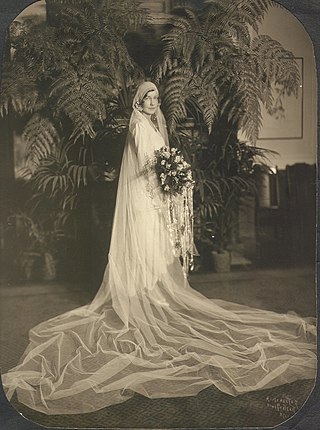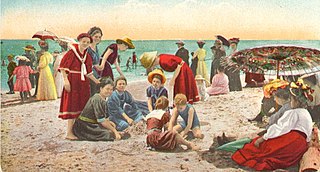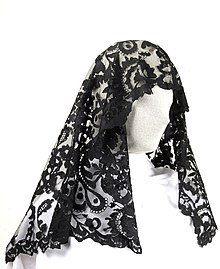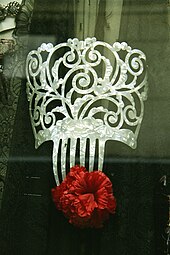
A veil is an article of clothing or hanging cloth that is intended to cover some part of the head or face, or an object of some significance. Veiling has a long history in European, Asian, and African societies. The practice has been prominent in different forms in Judaism, Christianity, and Islam. The practice of veiling is especially associated with women and sacred objects, though in some cultures, it is men, rather than women, who are expected to wear a veil. Besides its enduring religious significance, veiling continues to play a role in some modern secular contexts, such as wedding customs.

A bride is a woman who is about to be married or who is a newlywed.

Modesty, sometimes known as demureness, is a mode of dress and deportment which intends to avoid the encouraging of sexual attraction in others. The word modesty comes from the Latin word modestus which means 'keeping within measure'. Standards of modesty are culturally and context dependent and vary widely. In this use, it may be considered inappropriate or immodest to reveal certain parts of the body. In some societies, modesty may involve women covering their bodies completely and not talking to men who are not immediate family members; in others, a one-piece swimsuit is considered modest while wearing a bikini typically is not. In some countries, exposure of the body in breach of community standards of modesty is also considered to be public indecency, and public nudity is generally illegal in most of the world and regarded as indecent exposure. For example, Stephen Gough, a lone man attempting to walk naked from south to north in the United Kingdom, was repeatedly imprisoned. However, nudity is at times tolerated in some societies; for example by Digambara monks in India, who renounce clothing for ascetic reasons, and during a World Naked Bike Ride.

Bonnet has been used as the name for a wide variety of headgear for both sexes—more often female—from the Middle Ages to the present. As with "hat" and "cap", it is impossible to generalize as to the styles for which the word has been used, but there is for both sexes a tendency to use the word for styles in soft material and lacking a brim, or at least one all the way round, rather than just at the front. Yet the term has also been used, for example, for steel helmets. This was from Scotland, where the term has long been especially popular.

A headscarf is a scarf covering most or all of the top of a person's, usually women's, hair and head, leaving the face uncovered. A headscarf is formed of a triangular cloth or a square cloth folded into a triangle, with which the head is covered.

A doily is an ornamental mat, typically made of paper or fabric, and variously used for protecting surfaces or binding flowers, in food service presentation, or as a clothing ornamentation, as well as a head covering for Jewish women and Christian women. It is characterized by openwork, which allows the surface of the underlying object to show through.

1 Corinthians 11 is the eleventh chapter of the First Epistle to the Corinthians in the New Testament of the Christian Bible. It was authored by Paul the Apostle and Sosthenes in Ephesus. In this chapter, Paul writes on the conduct of Christians while worshiping together and enjoins the ordinances of headcovering and the Eucharist.
Outward holiness, or external holiness, is a Wesleyan–Arminian doctrine emphasizing modest dress and sober speech. It is a testimony of a Christian believer's regeneration, done in obedience to God. The doctrine is prevalent among denominations emerging during the revival movements, including the Methodists, as well as Pentecostals. It is taken from 1 Peter 1:15: "He which hath called you is Holy, so be ye holy in all manner of conversation."

Christian head covering, also known as Christian veiling, is the traditional practice of women covering their head in a variety of Christian denominations. Some Christian women, based on historic Catholic, Lutheran, Moravian, Reformed, Anglican, Methodist, and Plymouth Brethren teaching, wear the head covering in public worship and during private prayer at home, while others, especially traditional Anabaptist Christians, believe women should wear head coverings at all times, based on Saint Paul's dictum that Christians are to "pray without ceasing", Saint Paul's teaching that women being unveiled is dishonourable, and as a reflection of the created order. In Oriental Orthodox Christian and Eastern Orthodox Christian Churches, certain theologians teach the same doctrine that it is "expected of all women to be covered not only during liturgical periods of prayer, but at all times, for this was their honor and sign of authority given by our Lord", while other clerics have held that headcovering should at least be done during prayer and worship. Genesis 24:65 records the veil as a feminine emblem of modesty. Manuals of early Christianity, including the Didascalia Apostolorum and Pædagogus instructed that a headcovering must be worn by women during prayer and worship, as well as when outside the home.

A fascinator is a formal headpiece, a style of millinery. Since the 1990s, the term has referred to a type of formal headwear worn as an alternative to the hat; it is usually a large decorative design attached to a band or clip. In contrast to a hat, its function is purely ornamental: it covers very little of the head and offers little or no protection from the weather. An intermediate form, incorporating a more substantial base to resemble a hat, is sometimes called a hatinator.
Many Christians have followed certain dress codes during attendance at church. Customs have varied over time and among different Christian denominations. As with the Bible, the Church Fathers of Christianity taught modesty as a core principle guiding the clothing that Christians are to manufacture and wear.
Western dress codes are a set of dress codes detailing what clothes are worn for what occasion. Conversely, since most cultures have intuitively applied some level equivalent to the more formal Western dress code traditions, these dress codes are simply a versatile framework, open to amalgamation of international and local customs. This versatility has made this scale of formality a practical international formality scale.

Plain dress is a practice among some religious groups, primarily some Christian churches in which people dress in clothes of traditional modest design, sturdy fabric, and conservative cut. It is intended to show acceptance of traditional gender roles, modesty, and readiness to work and serve, and to preserve communal identity and separation from the immodest, ever-changing fashions of the world. For men, this often takes the form of trousers secured by suspenders, while for women, plain dress usually takes the form of a cape dress along with a headcovering.
Federal headship refers to the representation of a group united under a federation or covenant. For example, a country's president may be seen as the federal head of their nation, representing and speaking on its behalf before the rest of the world. Related to the created order, the concept of headship is taught in Christian theology, with respect to God, Jesus, man and woman. It has historically been externally reflected through the Christian practice of headcovering.
Religious clothing is clothing which is worn in accordance with religious practice, tradition or significance to a faith group. It includes clerical clothing such as cassocks, and religious habit, robes, and other vestments. Accessories include hats, wedding rings, crucifixes, etc.

A peineta is a large female head ornament hold to the hair by a row of teeth and usually worn under a mantilla, or lace covering the head, traditional in Spain and the rest of the Hispanic world.

Headgear, headwear, or headdress is any element of clothing which is worn on one's head, including hats, helmets, turbans and many other types. Headgear is worn for many purposes, including protection against the elements, decoration, or for religious or cultural reasons, including social conventions.

A church crown, also known as a church hat, is a decorative hat worn by women in the Southern United States as a headcovering during Christian church services in accordance with 1 Corinthians 11:2–13. Though church crowns were common among all American women until the mid-20th century, they continue to be worn in certain denominations that teach the historic practice of Christian headcovering, such as the Free Presbyterian Church and Plymouth Brethren, as well as in the black church. The practice of women wearing a headcovering, found in the Bible, "has been adapted and expanded to become a stylish part of Southern women’s churchgoing attire."

A kapp is a Christian headcovering worn by many women of certain Anabaptist Christian denominations, as well as certain Conservative Friends and Plain Catholics, in obedience to Paul the Apostle's command in 1 Corinthians 11:2–10.

A hanging veil, also known as a flowing veil or charity veil, is a type of Christian headcovering, which is worn by some Christian women continually, in obedience to Paul the Apostle's command in 1 Corinthians 11:2–10. Hanging veils enjoy popularity in a diverse array of Christian denominations, especially those of the Anabaptist Christian tradition. In certain Conservative Mennonite Anabaptist congregationations of the Beachy Amish Mennonite tradition, an opaque hanging veil is permitted as an alternative to the kapp if it covers as much or more hair as the kapp, which traditionally is "of ample size to cover most of the hair". Opaque hanging veils are usually white or black in colour for modesty. Hanging veils are designed to drape over the natural curves of a woman's head and hang down a woman's neck. Certain denominations of Christianity provide guidelines regarding the headcovering; the Ministry Training Center of the Biblical Mennonite Alliance, for example, teaches:
A veiling shall be worn by the sisters. We believe the best application of the headship principle as taught in I Corinthians 11 is for the veiling to be worn as a part of their regular attire to cover hair that is allowed to grow to its natural length. Ladies shall wear all their hair neatly up, avoiding fashion extremes, covered with a hanging veil, scarf, or traditional Mennonite covering of sufficient size to substantially cover the hair. Hanging veils and scarves must cover at least from the crown of the head to the bottom of the hair bun.























